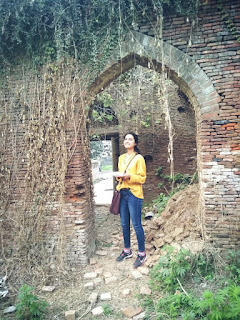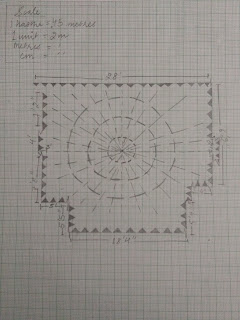SA Planning Workshop : Seeing More than Meets the Eye
 |
| Trishla is a research wing member at Speaking Archaeologically since August 2018 |
If you haven't read my last blog here, where I took about how we reached the site, its history and present status, it would be a good idea to read that first for what we call "more context". In this blog I'll only be dishing on how we resourcefully tackled our biggest handicap at the Sanghol site which as I had mentioned in that blog, was the lack of proper measuring tools. And while that would've made a great excuse for anyone to simply take pictures and head home, at Speaking Archaeologically you are taught, if not expected, to be resourceful.
Considering that our site was surrounded by farmland with plenty of trees around, sticks were readily available. Our only resort, therefore, at such a site was pointed out by our much admired senior at Speaking Archaeologically- Divyansh Thakur. This was a retreat back to the ancient times, when "Hasta and Angul" was one of the systems devised to measure a piece of land, under which, a safe idea could be formed of its size and extent. And then before we knew it, duties switched on site and Divyansh stepped in as our site instructor while Shriya retreated into the background letting her best student do the talking. We were asked to look for sticks or "Danda". Its size had to be one hasta, that is measured from the elbow to the tip of the middle finger and since the sticks had to be of a standard size for purposes of measurement, our standard in this case was Divyansh's arm. Interestingly enough, in ancient India sometimes the hasta is definitely mentioned as the "Hasta of the king" or that of a main Purohit or Pundit. So when an archaeologist studies it he/she can tell who funded its construction.
 |
| Members of Speaking Archaeologically at work on site at Sanghol |
Anyway coming back to the site, following up on the instructions we frantically looked around for the sticks, by "We" I mean the girls. The boys at site were too busy putting on layers after layers of sunscreen and enjoying whatever little time they could get in the shade of the trees before stepping in to do the actual work. Once the boys had finished up with the tenth step of their skincare routines to their utmost satisfaction, Shriya divided us into teams and the stupa into 4 sides-A,B,C and D for the purpose of mapping. A team of two people on each side measured the length of outer boundary. Once or twice I saw a farmer passing by looking visibly perplexed. The sight of ten kids crawling along the side of what to him is a "ruin" with sticks and paper, frowning, close to crying because of the heat (its a miracle none of us fainted!) and at times looking unusually happy is after all, not a regular sight. I wonder if he had any sleep that night trying to make sense of what he saw, for we did not. We spent the rest of the evening compiling the data, converting our observations to the modern metric system and replaying the day in our heads over and over for the emotional rollercoaster and thrilling adventure it was!
 |
| Site plan of Sanghol |
Having tackled the issue as heroically as we did,when we visited Bhima Devi for another planning workshop a month or so later this time armed with measuring tapes and knowledge about the modern metric system, I like the others assumed it would be a cakewalk or atleast a nice shift in paradigm. Our fascination for Bhima Devi was partly because of the number of times we had heard the name from our seniors and Shriya "as the place where it all began" and so the expectations were massive but God,were we disappointed! Expecting it to be a massive structure with sculptures intact and walls testament to greater times we were disappointed when what we saw was just the base or the plinth. But not ones to get too misled by first impressions we listened carefully as Divyansh along with Shriya our site instructors for the day, talked about the history of the site and explained to us the technique of construction employed in ancient temple building. Then followed the same process of measuring,mapping, drawing and plotting.
 | |
|
 |
| Site plan of Bhima Devi |
Before sitting down to write this blog, the site planning workshops at Sanghol and Bhima Devi were just content for great dinner table conversations for me or just something to casually boast about. In the course of writing this however I've realised that it is so much more than that .I didn't just learn planning that day, I gained perspective on a religion or a faith that I was born into but realised I lacked complete knowledge and thus appreciation of . Bhima Devi for example, built in the Panchayatana architectural style with all of its elements in interplay, display and celebrate the four important and necessary principles of human life under Hinduism- the pursuit of artha(prosperity,wealth), the pursuit of kama (sex,pleasure), the pursuit of dharma(virtues,ethical life) and the pursuit of moksha(release,self knowledge) and reflect the concept of plurality of beliefs central to it. Not just Hinduism, but all Indic religions like Buddhism,Jainism and even Sikhism preach the same predominant belief of multiple truths and realities under which there is no set path to get to the truth, one has to find their own way. All of which is reflective in their art,literature and architecture.
A temple or a stupa complex therefore, has an interplay of aesthetics, religion, science, geography so that each man can find enshrined in it something that matches his set of beliefs or appeals to his sensibilities. There is even room for agnosticism. Our architecture therefore, is reflective of our beliefs and understanding of the world.
Besides, archaeological remains are a limited, finite and non-renewable resource, in many cases highly fragile and vulnerable to damage and destruction thus, planning is important for recording them, understanding their significance in the past and in associating how the various elements are connected within the site, and how the site is connected with the world around it.
Humanity leaves immortal echoes through its history through the media of art,architecture and language. These are not just meant to be looked back at and to remember in hindsight but are primary to our time and define our civilisation at any given time, justifying our very sense of being human.



Comments
Post a Comment